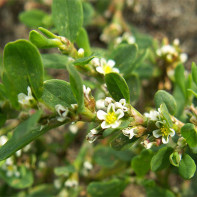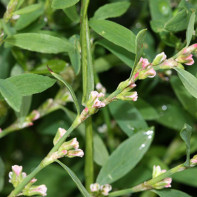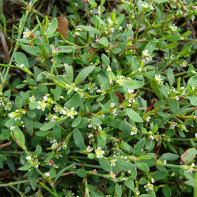Knotweed: medicinal properties and contraindications
Walking on a summer day, few people pay attention to what is growing on earth. But the grass, which rises slightly above the soil, has a large number of useful characteristics. This is a plant like knotweed. In the people, this grass still has many names. So, knotweed is called a grass-ants, a sparrow tongue, and buckwheat.
- Chemical composition
- How it looks and where it grows
- Collection and storage
- Medicinal properties of grass knotweed
- For women
- For men
- During pregnancy
- When breastfeeding
- For children
- When losing weight
- Knotweed in traditional medicine
- Types of healing compounds
- Infusion
- Tincture
- Decoction
- Tea
- Application in cosmetology
- Contraindications
This is a valuable medicinal plant that grows everywhere like a weed. Speaking about the healing properties of culture, it is probably easier to list what qualities it does not have, since knotweed is characterized by anti-inflammatory, hemostatic, astringent, diuretic effect. Moreover, it promotes the healing of decaying wounds and ulcers, increases immunity, and lowers blood pressure.
The lack of such medicinal plant materials is not observed, since the mountaineer bird grows everywhere, except for the regions of Antarctica and the Far North, as well as deserts.
Chemical composition
A rather unremarkable-looking grass is characterized by a special, rich chemical composition, which allows it to be used in the fight against various diseases.
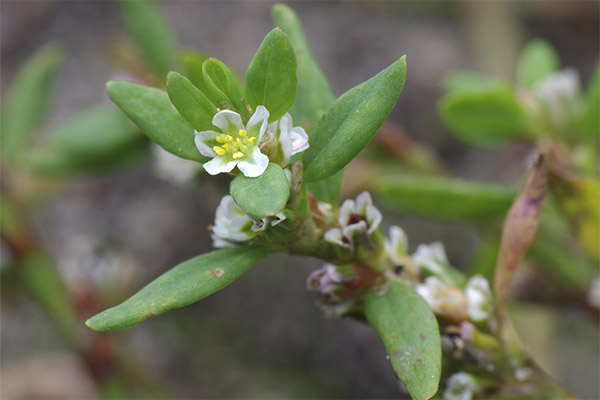
Many flavonoids that have antioxidant properties have been found in raw materials. Moreover, this group of substances helps to reduce the permeability and fragility of the blood vessels of the circulatory system, and also has an antimicrobial effect.
Organic acids are also present in sporosh. From this group, ascorbic acid is found in the plant, which takes part in the production of collagen, serotonin, interferon, and neutralizes toxins in the liver. Also, this compound has a neuroprotective property. Of the organic acids, silicic acid is also found in the product, which is designed to strengthen the walls of blood vessels, cartilage and tendons. In addition, this substance provides the dissolution of stones in the urinary system.
Vitamin K as part of the product takes part in the process of blood coagulation and bone tissue development. Tocopherol protects cells from oxidation, reduces their need for oxygen.
Also, the plant is saturated with tannins with antimicrobial properties.
The composition of the mountaineer contains traces of essential oil. This substance has a healing and cleansing effect. Resins present in the grass are characterized by disinfecting and wound healing effects. Mucus has an enveloping and laxative property. In addition, fats and carbohydrates, which are the main nutrient components of knotweed, are found in the culture.
In addition, a number of minerals were discovered in the medicinal plant: Cu, Zn, Co, Cr, Mn, Ni. These compounds provide the production of enzymes and are involved in material metabolism.
How it looks and where it grows
Highlander bird is an annual herbaceous plant belonging to the buckwheat family. It grows everywhere, forming under normal conditions a thick carpet.
The knotweed has a branched, lying stalk, which can reach a length of 70–80 cm. The culture spreads along the ground, has a hard knotted stalk and branching shoots. The root is poorly developed. The leaves are small, short-leaved, have a grayish-green color.
The flowers of the grass-ants are also small, attached to the sinuses of the leaves, collected in bunches of several pieces. Flowering is carried out in July-August. The fruit of the plant is presented in the form of a trihedral nut of dark color, resembles a buckwheat seed, ripening lasts from early summer to mid-autumn. Propagated by seeds.So, in one sporosh about 500 seeds are concentrated, which are able to germinate over five years.
Highlander bird is highly resistant. Even if the plant is trampled, it is able to quickly capture new territories, grows quite quickly after mowing. It is found throughout the former Soviet Union, except for the Arctic. The grass is unpretentious, spreads in any climatic conditions, even in Siberia and the Urals, grows in the fields, along roads, on the banks of water bodies. Goose grass receives nutrients both directly from the depth and from the surface of the soil. It is not demanding on the composition of the soil, it can grow even on clay and gravel.
Collection and storage
Maggot ordinary and preparations based on it can be found in almost any pharmacy or market. Highlander grass can also be collected and prepared independently. It is important to follow some rules.
First of all, you need to know that collecting near busy roads and pastures should not be done. This is due to the fact that grass is able to accumulate salts of heavy metals. Therefore, it is best to collect raw materials in forest areas with good sunlight.
Maggot is harvested from May to June, so it is at this time that active growth is observed. In addition, during this period, bird buckwheat has the richest composition. In late summer and early autumn, the stems of the mountaineer coarse and dry.
The plant must be carefully picked, in this case it is best to collect young leaves without damaging the entire branch. The most useful and juicy are plants that grew in shaded areas. However, taking only such copies is not worth it, because due to the lack of sufficient sunlight, photosynthesis in them is slightly weaker, which affects the healing properties of the product.
The roots of the plant are undesirable, it is best if they remain in the ground. Over time, a new knotweed will appear at this place.
For medicinal purposes, only the ground part should be prepared. In this case, the length of the cut shoots should be no more than 40 cm from the top. The prepared raw materials must be dried in the attic or in another well-ventilated room, in the shade, while constantly turning the grass over. Dry knotweed becomes brittle. The dried workpiece should be packed in cloth bags or sealed glass containers and stored for three years.
Medicinal properties of grass knotweed
About the healing qualities of this plant has been known to people for a long time. The scope of its application is quite wide. The culture can be used both for preventive purposes and for the treatment of a wide range of diseases.
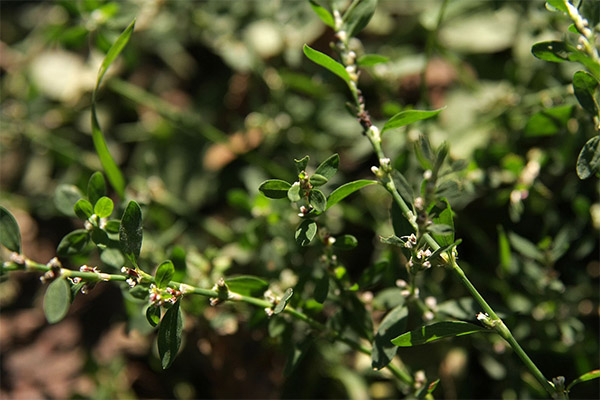
Most often, the herb is used in the treatment of diseases related to the genitourinary sphere. So, medicinal raw materials can be used in the presence of stones in the urinary tract. At the same time, the plant facilitates their departure in a natural way, without requiring surgical intervention. Due to the anti-inflammatory properties, together with the removal of stones, an antimicrobial effect is immediately apparent, which helps prevent the development of pyelonephritis.
Another popular quality of goose grass is that, like plantain, it can stop bleeding and sanitize a wound site. For a long time, people have used this culture for injuries sustained while hunting or when picking mushrooms.
The use of highlander in the veterinary field is also known. Cattle often suffer from insect bites such as bees, midges, flies, mosquitoes. In this case, a compress is applied to the bite site, for which it is necessary to crush a little knotweed. The resulting slurry should be applied to the bitten area. The components of this plant have an astringent effect, therefore, it provides faster healing of wounds and recovery of the animal.
It is also known that the grass-ants are able to tone vessels, which allows you to maintain blood pressure at an optimal level.
It is also worth noting the preventive benefits of grass.Squeezed knotweed is enriched with many vitamins and minerals. So, already in several leaves the daily requirement for ascorbic acid, in vitamin K is concentrated.
It must be remembered that ordinary knotweed cannot be the only way to treat a specific disease. First you need to undergo a medical examination, consult a specialist and only after that, as an additional therapy, use highlander-based drugs.
For women
In gynecology, the highlander is used in the treatment of infertility. The components of this plant provide strengthening of the muscles of the small pelvis, stabilize the state of the uterus, gradually restore the activity of the ovaries, and also nourish the body with oxygen. All these points increase the chances of conceiving a child.
To prepare a remedy for infertility, pour 20 g of dry raw materials into a glass of codes. After this, boil the mixture for several minutes, and then insist. Take 2 tbsp. several times a day.
In addition, the plant can be used for painful and heavy menstruation, bleeding that occurs after childbirth, whitewash, and even during the menopause.
Bird grass is also useful for the fairer sex and in that it copes well with wounds, bruises, and bruises. At the same time, it provides quick healing, eliminates itching and relieves inflammation.
For men
Due to the diuretic properties, knotweed becomes an effective tool in the presence of intoxication of the body caused by the action of any poisons. This allows you to use it if a person works in hazardous industries.
Highlander decoctions provide a reduction in blood pressure.
It is known that more often representatives of the stronger sex face diseases of the cardiovascular system. That is why knotweed will be especially useful for them. The plant can be used for heart neurosis and tachycardia, which occurs in this case, and to reduce the permeability of the walls of blood vessels. In the presence of poor coagulability, it is also recommended to take drugs based on this culture, since it has the ability to increase it.
There are fees, which include the grass-murava. Such complexes are used for impotence. For such purposes, a recipe consisting of 20 g of knotweed, the same amount of St. John's wort, 15 g of oregano and elecampane root, as well as yarrow and lemongrass taken in 10 g each is suitable. A tablespoon of the resulting mixture will need to be filled with 400 ml of hot water, insisted until it cools, filter and take 50 ml 4 times a day. The course of treatment should continue for two weeks.
With this herb, you can treat hemorrhoids, using microclysters and douching with water infusion, taking baths, making lotions with cotton soaked in a strong broth. The plant is endowed with anti-inflammatory properties, which explains its positive therapeutic effect.
In the course of medical research, it was found that prostatitis develops in men due to a lack of zinc in the body. In sporosh contains a high concentration of this substance, so it can be used as a source of zinc using tea prepared according to the instructions.
In addition, with prostatitis, you can use the collection, consisting not only of the highlander, but also yarrow, dandelion, St. John's wort, plantain, mint, clover, sweet clover and lingonberry. All of these ingredients should be mixed. 1 tbsp pour the resulting collection into a container with 500 ml of boiling water. The mixture should be infused for an hour. Drink the finished drink 100 ml three times a day. This decoction can be used for microclysters.
During pregnancy
Maggot is able to cause severe uterine contractions, so its use during child bearing is contraindicated. However, the product will help to tread this excellent position. A highlander-based drug can be prescribed by a family doctor to increase the chances of conceiving a baby with infertility.
When breastfeeding
Maggot is used as a remedy for postpartum, fibromic bleeding, and blood loss associated with an abortion. In addition, it is indicated for inflammatory diseases of the genital organs.
Highlander tea will be a useful drink, as it will help support the weakened body of a young mother, replenish it with reserves of ascorbic acid, tannins. However, everything should be in moderation. You should not abuse such a drug while breastfeeding.
For children
Hot broth and tea from knotweed grass will help the child with a cold. In this case, the drink will have a restorative and tonic effect.
With diarrhea, children can be given a decoction, for the preparation of which it is necessary to mix in equal parts the grass of blackberry, highlander, blackthorn fruit and the marshmallow root. The resulting collection in the amount of 0.5 tbsp. pour 250 ml of boiling water and then just insist for 30 minutes. Ready to give the child a morning on an empty stomach, as well as before lunch and dinner, 100 ml.
If children have skin diseases, you can take baths with a decoction of this herb. Teen acne can also be cured with tea from bird grass. Such a course of treatment is best carried out in spring and autumn. In this case, the medicinal composition should be used every day for 2-3 weeks.
To obtain such a healing drink you need 1 tbsp. mix knotweed with 100 ml of water and boil. Strain the liquid before use.
When losing weight
The mountaineer bird has many healing properties. In addition, it can be used and, if necessary, lose weight. Decoctions based on such a plant contribute to the removal of excess fluid, cleansing the intestines. Also, the plant helps to reduce appetite, improve digestion and stabilize the body's metabolism.
In the treatment of obesity, knotweed is still valued for having a choleretic, diuretic effect. It also provides a decrease in blood glucose levels, enhances and normalizes metabolic processes in the body.
To get rid of excess weight, it is necessary to prepare a healing broth according to the following recipe: 1 tbsp. pour raw materials with a glass of boiling water, leave for 2-3 hours, after which the drink is ready to drink. Drink it 2/3 cup several times a day.
Since the mountaineer bird has a diuretic and mild choleretic effect, it is recommended to consult a specialist before using it.
Knotweed in traditional medicine
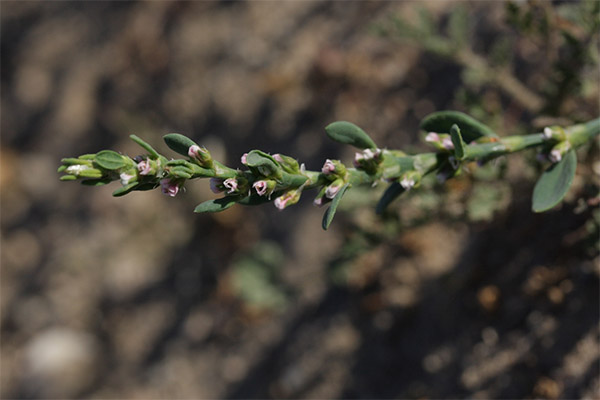
- Highlander is used to treat kidney failure and remove kidney stones. Pain in the presence of kidney stones and other pathologies is very strong. Maggot, providing a diuretic effect, increases the amount of urine, which helps to remove stones from these organs.
- Alcohol tincture from this plant allows you to cope with varicose veins. In addition, the grass has an astringent property, so it is effective in treating wounds, bleeding, hemorrhoids and diarrhea.
- Useful highlander in the treatment of acute respiratory viral infections, diseases of the oral cavity and throat.
- Knotweed reduces sweating that occurs with tuberculosis, helps with bleeding and swelling of the gums.
- Grass prevents severe menstrual bleeding and bloody nose discharge. In addition, the highlander is considered an effective tool for removing helminths from the body.
- The herb contains silicic acid, which helps to treat lung diseases, as it strengthens the connective tissue directly inside the organs.
- With fever and inflammatory processes, the grass is an anesthetic, and the seeds have emetic and laxative qualities.
- You can use the product for metabolic disorders, contributing to weight loss.
- Effective medications of knotweed in infertility, have beneficial effects on uterine muscle contractions.
- Grass improves appetite.
- Highlander's decoction, prepared in milk, is used to reduce seizures.
- Often, the plant is included in fees that are used in the treatment of scurvy, gout, cystitis, whooping cough.
- As an antibacterial agent, you can use knotweed for baths.
- The plant is taken to remove kidney stones. To get the drug, you need to prepare a decoction, consisting of 3 tsp. raw materials and 200 ml of cold water. Cook the resulting mixture for 30–40 minutes over low heat. After that, cool the solution, filter and use in the morning.
- To cure jade, it is necessary to mix horsetail and pikulnik grass in equal parts, and also add two parts of the mountaineer. Pour a tablespoon of the resulting composition with a glass of boiled water, insist 5-6 hours and drink a glass twice a day.
- Useful knotweed in diseases of the skin. It is necessary to grind fresh grass and in the form of slurry to apply to the affected areas of the dermis. To eliminate the effects of burns and heavily healing wounds, you can prepare an infusion of alcohol from this herb. In this case, 2 tsp. knock up a bottle of 250 ml of alcohol. This mixture is infused for ten days. After that, filter the solution and drink 15–20 drops several times a day, previously diluting with water. Wipe hands and feet with joint alcohol solution diluted with water.
- With diarrhea, the following decoction is shown: you need to take oak bark and bird buckwheat in equal parts. Pour a large spoon of the collection into 400 ml of boiled water, bring to a boil and insist for half an hour. Take 100 ml 2-3 times a day.
- It is possible to alleviate the condition during painful menstruation with the help of a solution obtained from one part of grass ant, horsetail, three parts of centaury and five parts of goose cinquefoil. A mixture of herbs pour hot water in the amount of one glass. Allow the mass to brew, then strain and drink in small sips throughout the day.
- With severe menstrual and uterine bleeding, it is recommended to brew 1 tbsp. dried raw materials of this plant in 200 ml of boiling water, leave for 60 minutes and filter. The resulting composition to drink several times a day for 1 tablespoon.
- Adhesive processes often develop in the fallopian tubes. In this case, 3 tsp. mix knotweed with 500 ml of hot water. Let the mass brew for 4 hours. Take a prepared broth of 100 ml 2-4 times a day before a meal.
- To stimulate the ovaries, you need to prepare a healing composition. To do this, take two parts of the common cuff and inflorescences of the meadowsweet and one part of the mountaineer, sage and clover. Mix the resulting mixture of herbs and measure 1 tbsp. collection. Pour 250 ml of water with this amount of raw material and insist on a water bath for a quarter of an hour. After that, filter the mixture. Bring the collected solution to 250 ml with boiled water. Also, add 1.5 ml of tincture of golden root here. The resulting medicine is taken three times a day on an empty stomach in 1/3 cup.
- With cystitis, brew 1 tbsp. herbs with hot water in an amount of 1 cup. After this, the solution is infused for a couple of hours. The composition is consumed in a third of a glass in 3 divided doses.
- Myoma can also be treated with bird buckwheat. Preparing a healing composition is very simple. In this case, you have to mix four parts of ants-ants, 0.5 parts of celandine and 1.5 parts of water pepper. Pour the resulting collection with 350 ml of water and insist in a thermos for half an hour. Filter the finished mixture, after which take 100 ml three times / day 30 minutes before meals.
Types of healing compounds
Almost all parts of the mountaineer bird, with the exception of the roots, are characterized by healing properties, therefore, there are many ways to prepare medicinal compositions from this plant. Each option to get a home remedy is effective, but it should be treated in this way only after consulting a specialist.
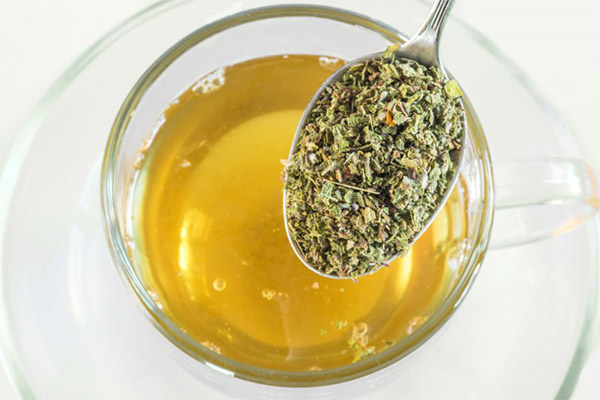
Infusion
The easiest way to get the infusion is a mixture of 50 g of dried raw materials with 0.5 l of boiled water, cooled to room temperature.After that, cover the dishes with the workpiece and insist for 1-2 hours. Then strain the mass. Ready to take 1 tbsp. 25 minutes before eating. Repeat the procedure at least 3 times a day.
Such a healing infusion will help with gastritis and stomach ulcers, uterine bleeding. It also helps increase acidity in the stomach.
Tincture
To obtain a tincture, a container of such dimensions is required that the number of components fits, depending on the required volume. First you need to measure 200 ml of alcohol, you can use vodka or ethyl alcohol of 40 degrees. After that add dry knotweed in the ratio of 1/4 of the amount of alcohol used. Then, for 5-6 hours, insist. Before use, filter the resulting mixture. The collected cake can be used to apply a compress.
Maggot has a number of healing qualities. Preparations from it are prepared very easily, which makes grass popular. This alcohol tincture is recommended for use in gallstone disease, hepatitis and other liver pathologies.
Decoction
To prepare a medicinal decoction, it is necessary to take a dried plant and boiled water at the rate of 1 tbsp. raw materials per 100 ml of water. After pouring grass with boiling water, cook the workpiece over low heat for a quarter hour. The filtered solution should be taken before meals. The optimal dosage is 1 tbsp. The course of treatment lasts no more than two weeks.
Such a drug can be used for liver diseases, pyelonephritis and other pathological conditions of the urinary system.
Tea
To make knotweed tea you will need a small porcelain teapot. The minimum volume of such dishes should be 250-300 ml. If one is not found, an ordinary custard or simple cup is suitable. Place 2-3 tbsp in this container. shredded highlander bird. Pour a measured amount of grass with boiled water and send to a cool place for insisting. It usually takes no more than half an hour. After this, the solution is ready for use.
If you plan to add other medicinal plants, you need to add them even at the stage of measuring dry raw materials. In this case, the mixture of herbs must be thoroughly mixed so that the batch acquires a uniform structure and only then pour boiling water.
Application in cosmetology
Doctors categorically prohibit self-medication. This applies in particular to medicinal plants. Particular attention is required by knotweed, as quite a lot of conflicting information is found on the Internet. Before being treated with this herb, it is important to consult a doctor.
A decoction of knotweed is used to wash and treat problem skin. The solution helps in eliminating boils, rashes, blackheads. Acne can be removed with the help of gruel from fresh plant materials. It is enough to attach the resulting mixture to problem areas. This method will also cure boils.
In folk medicine, this herb is used to treat wounds and sores. In this case, you should prepare a tool consisting of 500 ml of vegetable oil and half a glass of crushed knotweed. After mixing these components, send the mass to a dark place for infusion, which lasts an average of 10 days. Apply the resulting composition as a wet dressing to the affected areas for 15–20 minutes.
To strengthen the hair roots and get rid of dandruff, you can prepare a special tool for rinsing. The recipe for such a cosmetic product is quite simple. It is necessary to grind only 25 g of dry mountaineer bird by any convenient method, add 2.5 l of boiled water and let stand on a steam bath for about 10 minutes.
The infusion prepared according to the main recipe is used as a healing composition for excessive hair loss.In this case, the liquid must be rubbed into the dermis of the head every day with massaging movements for a quarter of an hour. The procedure should be repeated 3-4 weeks, after which it is recommended to take a break for a month. The same solution can be used as a rinse after washing your hair with shampoo.
Contraindications
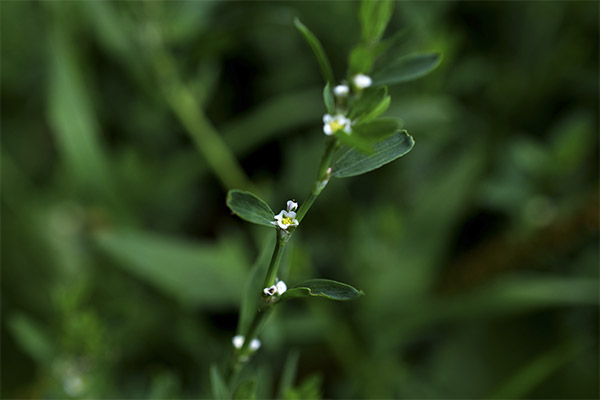
Despite a wide range of useful qualities, an anthill grass does have some limitations and contraindications.
Incorrect preparation of medicines, as well as non-compliance with the indicated doses, is very dangerous. Do not self-medicate. Before conducting a wellness course, it is important for a mountaineer to consult a doctor to avoid possible unpleasant consequences.
In addition, as noted above, bird buckwheat can lead to uterine bleeding, which is very dangerous during the period of expectation of the baby. Indeed, in this case, it can lead to a miscarriage. Take the drug with caution during lactation.
Thrombophlebitis is a contraindication to the use of knotweed for therapeutic purposes, since the plant contributes to blood clotting, varicose veins. Allergic reactions to the product are also known.
With the wrong dosage, plant-based drugs can cause angina pectoris, stroke, and heart attack. With extreme caution, knotweed should be consumed by the elderly.
Highlander bird can increase intestinal motility, which can be dangerous for people who suffer from constipation, as well as in the presence of stones in the gall bladder. In the treatment of gallstone disease, not all stones are crushed, as a result of which large ones can become stuck in the bile ducts.
Seeds and foliage of knotweed are toxic. Previously, they were used to cause diarrhea or vomiting during intoxication with poisons.
«Important: all information on the site is provided exclusively in fact-finding purposes. Before applying any recommendations, consult with a profile specialist. Neither the editors nor the authors are liable for any possible harm caused materials. "



